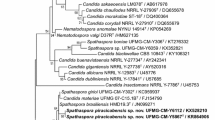Abstract
Candida arabinofermentans (type strain NRRL YB-2248, CBS 8468), a new yeast that ferments the pentose L-arabinose, is described. The three known strains of this new species were isolated from insect frass of pine and larch trees in the U.S. Phylogenetic analysis of nucleotide sequences from the D1/D2 domain of large subunit (26S) ribosomal DNA places C. arabinofermentans among the methanol-assimilating yeasts and most closely related to Candida ovalis. Strains of the new species produce 0.7-1.9 g/l ethanol from L-arabinose.
Similar content being viewed by others
References
Dien BS, Kurtzman CP, Saha BC & Bothast RJ (1996) Screening for L-arabinose fermenting yeasts. Appl. Biochem. Biotechnol. 57/58: 233–242
James SA, Cai J, Roberts IN & Collins MD (1997) A phylogenetic analysis of the genus Saccharomyces based on 18S rRNA gene sequences: description of Saccharomyces kunashirensis sp. nov. and Saccharomyces martiniae sp. nov. Int. J. Syst. Bacteriol. 47: 453–460
Jeffries TW & Kurtzman CP (1994) Strain selection, taxonomy, and genetics of xylose-fermenting yeasts. Enzyme Microb. Technol. 16: 922–932
Kurtzman CP (1984) Synonymy of the yeast genera Hansenula and Pichia demonstrated through comparisons of deoxyribonucleic acid relatedness. Antonie van Leeuwenhoek 50: 209–217
Kurtzman CP & Fell JW(1998) Summary of species characteristics. In: Kurtzman CP, Fell JW (Eds) The yeasts, a taxonomic study, 4th edn. (pp 915–947). Elsevier Science BV, Amsterdam
Kurtzman CP & Robnett CJ (1991) Phylogenetic relationships among species of Saccharomyces, Schizosaccharomyces, Debaryomyces and Schwanniomyces determined from partial ribosomal RNA sequences. Yeast 7: 61–72
Kurtzman CP & Robnett CJ (1995) Molecular relationships among hyphal ascomycetous yeasts and yeastlike taxa. Can. J. Bot. 73: S824–S830
Kurtzman CP & Robnett CJ (1997) Identification of clinically important ascomycetous yeasts based on nucleotide divergence in the 5 & #x2032; end of the large subunit (26S) ribosomal DNA gene. J. Clin. Microbiol. 35: 1216–1223
Kurtzman CP & Robnett CJ (1998) Identification and phylogeny of ascomycetous yeasts from analysis of nuclear large subunit (26S) ribosomal DNA partial sequences. Antonie van Leeuwenhoek. accepted.
Payne RW, Kurtzman CP & Fell JW (1998) Key to species. In: Kurtzman CP, Fell JW (Eds) The yeasts, a taxonomic study, 4th edn. (pp 891–913). Elsevier Science BV, Amsterdam
Peterson SW & Kurtzman CP (1991) Ribosomal RNA sequence divergence among sibling species of yeasts. Syst. Appl. Microbiol. 14: 124–129
Price CW, Fuson GB & Phaff HJ (1978) Genome comparison in yeast systematics: Delimitation of species within the genera Schwanniomyces, Saccharomyces, Debaryomyces and Pichia. Microbiol. Rev. 42: 161–193
Swofford DL (1993) PAUP: phylogenetic analysis using parsimony. version 3.1.1. Illinois Natural History Survey. Champaign
Wickerham LJ (1951) Taxonomy of yeasts. USDA, Washington, D. C. Tech. Bull. 1029
Wickerham LJ (1969) New homothallic taxa of Hansenula. Mycopathol. Mycol. Appl. 37: 15–32
Yamada Y, Maeda K & Mikata K (1994) The phylogenetic relationships of the hat-shaped ascospore-forming, nitrate-assimilating Pichia species, formerly classified in the genus Hansenula Sydow et Sydow, based on the partial sequences of 18S and 26S ribosomal RNAs (Saccharomycetaceae): The proposals of three new genera, Ogataea, Kuraishia, and Nakazawaea. Biosci. Biotechnol. Biochem. 58: 1245–1257
Yarrow D (1998) Methods for the isolation, maintenance and identification of yeasts. In: Kurtzman CP, Fell JW (Eds). The yeasts, a taxonomic study, 4th edn. (pp 77–100) Elsevier Science BV, Amsterdam
Author information
Authors and Affiliations
Rights and permissions
About this article
Cite this article
Kurtzman, C., Dien, B. Candida arabinofermentans, a new L-arabinose fermenting yeast. Antonie Van Leeuwenhoek 74, 237–243 (1998). https://doi.org/10.1023/A:1001799607871
Issue Date:
DOI: https://doi.org/10.1023/A:1001799607871




